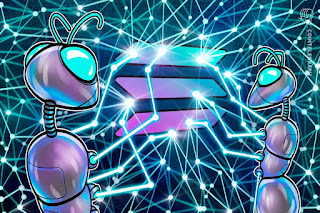Key Technologies That Make Solana The First Web-Scale Blockchain
In 2017, Solana launched as a decentralized blockchain platform. It supports a variety of Dapps as well as smart contracts, including NFTs. For staking and paying transaction fees, Solana has its own cryptocurrency, SOL. Additionally, it gives holders the right to vote on future upgrades. Solana Blockchain development is one of the fastest blockchains for a smooth dApp development with features like minimum gas fee and cross-chain dApp hosting.
Due to the NFT hype and monstrous growth, Solana became one of the hottest projects last year. Solana is praised for its speed, capabilities, and scalability, making crypto enthusiasts scoff.
Solana's eight key technologies enable the creation of decentralized, permissionless networks with a performance equivalent to a single node:
Proof of History (POH)
Tower BFT
Turbine
Gulf Stream
Sealevel
Pipelining
Cloudbreak
Archivers
Now let’s explain each of the above.
- Proof of History (POH) - Proof of History (POH) is the core innovation of Solana, a permissionless, globally available source of time in the network. This protocol does not work as an anti-Sybil mechanism or a consensus protocol. Rather, POH is a solution to the clock problem.
- Tower BFT - To achieve consensus, Solana uses Tower Consensus, an algorithm that is similar to PBFT and takes advantage of the synchronized clock. Tower Consensus is a liveness-pleasing algorithm, as opposed to PBFT's consistency-centric strategy. Like PBFT, nodes exponentially increase their timeouts to come to an agreement.
- Turbine - Independent of consensus, Solana optimizes the transmission of blocks through the network. A key component of Solana's block-propagation technology is Turbine, a technique inspired by BitTorrent. An erasure code and a small packet are separated from a block, which is then distributed among a large number of random peers.
- Gulf Stream - Memorypool management is a new problem in high-performance networks that other chains don't really have to deal with. Through Gulf Stream, transactions are cached and forwarded to the edge of the network. Since every validator knows the order of upcoming leaders in Solana architecture, clients and validators forward transactions to the expected leader ahead of time. This allows validators to execute transactions ahead of time, reduce confirmation times, switch leaders faster, and reduce the memory pressure on validators from the unconfirmed transaction pool.
- Sealevel - Sealevel uses Solana's high-speed network to run hyper-parallel transactions across GPUs and SSDs. A single-threaded computer is all that exists on all other blockchains. With one shard of SOLANA, all transactions can be executed simultaneously (not just signature verification).
- Pipelining - The Solana network uses pipelining extensively to validate transactions. When a stream of data needs to be processed in a sequence by different hardware, pipelines are the best approach.
- Cloudbreak - A simple scaling of computation is not sufficient. As the number of accounts grows, the size and speed of the memory that keeps track of them become a bottleneck. RAM is a naive solution for storing global states. The global state cannot be stored in a consumer-grade machine, however, since they don't have enough RAM. The cloudbreak state architecture designed for Solana is optimized for simultaneous reads and writes across SSDs arranged in a RAID 0 configuration. The additional disks expand the amount of storage available to on-chain programs, as well as their ability to run concurrently.
Archivers - In Solana, data storage is delegated to a network of nodes known as Archivers. As far as consensus is concerned, archivers do not participate. The archivers are responsible for storing small parts of the state. Archivers are periodically asked by the network to prove that they are storing the data they should. As a measure of replication, Solana uses Proofs of Replication (PoRep), which are heavily inspired by Filecoin.
Solana is a lightning-fast distributed ledger technology due to these 8 major innovations. The consensus process does not stifle it. Additionally, the system optimizes data propagation, utilizes parallel GPUs to process transactions in parallel, and does not weigh down validators with excess chain history.




Comments
Post a Comment